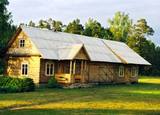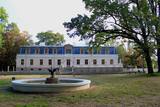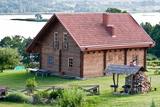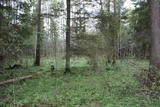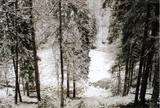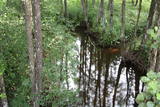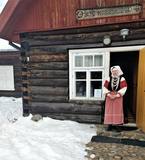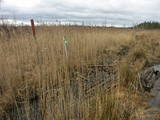| Nr | Nosaukums | Apraksts |
|---|---|---|
|
Lauku sētas atrodas pie upītes, ciema nomalē, kas jau izsenis bijusi mājvieta biškopjiem. Vieta piemērota mierīgai atpūtai. Izglītojošas nodarbības ikvienam, kas ir ieinteresēts Dzūkijas kulinārajā mantojuma, amatniecībā un tradīcijās. Maizes cepšana, pīrāgi ar sēnēm, olu rotāšana ar vasku, pinumi no salmiem. Vakarēšana ar dzuku dziesmām un dejām. Tautastērpu izgatavošana gan bērniem, gan pieaugušajiem. |
||
|
Ērgļu novada R. Blaumaņa memoriālais muzejs „Braki” ir izcilā latviešu novelista un modernās dramaturģijas pamatlicēja Rūdolfa Blaumaņa (1863–1908) dzīves un darba vieta. Muzejā ir apskatāmas astoņas koka guļbūves ēkas (restaurētas no 1958. līdz 1992. gadam), kas ir līdzīgas kā rakstnieka dzīves laikā, – dzīvojamā māja ar namiņu, drēbju klēts, rija, labības klēts, govju kūts, zirgu stallis, sīklopu kūts un pirts. Ēkās ir izvietota pamatekspozīcija „„Braki” – Ērgļu pagasta zemnieka rentnieka sēta – rakstnieka Rūdolfa Blaumaņa dzīves un darbavieta (1868–1908)”, kurā var aplūkot 19. gs. beigu un 20. gs. sākuma darbarīkus, saimniecības un sadzīves priekšmetus, kā arī iepazīties ar periodiski veidotām tematiskām izstādēm. Pie ieejas muzejā atrodas O. Skaraiņa skulptūra „Rozes mātei”(1992). Plašajā teritorijā ir iespēja izstaigāt dabas takas, aplūkojot Zibensšķelto akmeni, L. Līces skulptūru „Edgars” (1990), Simtsoļu taku, Lejas aku, Noliņa ābeli, Pieminekļa akmeni, Jānkalniņu, Pirtsgravas avotiņu. Apmeklētājiem tiek piedāvāti izglītojoši pasākumi un tematiskas ekskursijas (ģimeņu godi, velniņu nedarbi, darbi lauku sētā, kāzu ekskursijas „Silmaču” noskaņās), kā arī iespēja baudīt „Braku” putru, „Silmaču” pankūkas, tēju un vīnu „No saldenās pudeles”. Muzeja teritorijā atrodas rotaļlaukums bērniem un atrakciju parks „Braku takas”, kas piedāvā pārvarēt pārbaudījumu un šķēršļu trasi; darbojas disku golfs. |
||
|
Kafejnīca piedāvā svaigi gatavotus mājas ēdienus. "Cafe 21 & Putnu Dārzs" izīrē telpas banketu, svinību,mielastu, furšetu un semināru rīkošanai. Veic ēdienu piegādi un izbraukumu servisu. |
||
|
Tornis atrodas Dundagas – Mazirbes ceļa malā, Šlīteres Zilo kalnu nogāzes augšdaļā. No tā paveras jauks skats uz piejūras zemienes mežiem, ceļu un nelielu Baltijas ledus ezera senkrasta posmu.
|
||
|
Tulkojumā no Igauņu valodas Luitemaa nozīmē „Kāpu zeme”. Tā ir Pērnavas līča piekrastes teritorija 13 km garumā starp Vöiste un Häädemeeste ar seklūdeņiem, plašām piejūras pļavām, Igaunijas augstāko kāpu masīvu un Tolkuses purvu (Tolkuse raba). Kāpu un purva apskates nolūkā ir izveidota Tolkuses purva izziņas taka (~ 2,2 km) un skatu tornis. Atrodas Luitemā dabas liegumā. |
||
|
Saimniecības darbības veidi: liellopu un jaunlopu, garšaugu, mētru un bērzu stādu audzēšana un realizācija. Tūrisma pakalpojumi - apskatāmas skulptūras no sūnām un citiem materiāliem, saimniecības un dzimtas vēsture, seni darbarīki, ārstniecības augu, garšaugu un dažādu veidu mētru kolekcija, putni un poniji. |
||
|
Žagares reģionālais parks organizē dažādas ekskursijas, izglītojošas programmas bērniem un senioriem un jauniešu nometnes. Žagare jau sen ir pazīstama ar savu īpašo ķiršu šķirni, kuru Latvijā pazīst ar nosaukumu ‘Latvijas zemais’, bet lietuvisko nosaukumu varētu tulkot kā ‘Žagares ķirši’. Tai ir vairākas variācijas, kas atšķiras ar dažādu nogatavošanās laiku, ražīgumu, augļu koku formu un citam pazīmēm. Līdz pat mūsdienām šie ķirši aug gandrīz ikvienās mājās un ir kā ekskluzīvs Žagares simbols. |
||
|
Izvijas cauri kādreizējiem zvejnieku ciemiem. Labākā velobraukšanas alternatīva posmā no Häädemeeste līdz Ainažiem. |
||
|
Restorāns "Višta puode" piedāvā dažādus gardus ēdienus, tostarp arī lietuviešu tradicionālos ēdienus. Restorāna telpas iespējams rezervēt dažādiem pasākumiem. |
||
|
Iespēja iepazīties ar mājas vīna gatavošanas procesu, un kopā ar Krimuldas muižas vīndari izzināt mājas vīna gatavošanas noslēpumus un degustēt vīnu, kas pagatavots no dažādām ogām. Vīna īstā garša vislabāk atklājas, klausoties stāstus par muižas dzīvi! |
||
|
Atrodas pie Jēkabpils apvedceļa (Rīgas virziens) – tirdzniecības centrā „Sala”, 0,2 km no mazās Daugavas. Omulīgas un telpas, kas dekorētas ar dabīgiem ziediem. Piedāvā maltītes visām ēdienreizēm. |
||
|
Ģimenes uzņēmums piedāvā kvalitatīvus tradicionālos Gaujas Nacionālā parka biškopības (~ 110 saimes) produktus – medu, ziedputekšņus, bišu maizi, vasku un propolisu un rada jaunus, tirgū līdz šim nebijušus produktus, kas apmierina klientu vēlmes pēc kaut kā neierasta, taču veselīga. Ekskursija, medus iegāde. |
||
|
Atrodas ezera Vilkokšnio ezera krastā - attālā dabas nostūrī, kur smelties spēku un enerģiju. Pirts, guļamistabas ar koka smaržu, vasaras lapene, kamīns, rotaļlaukums, peldēšanās ezerā, makšķerēšana, sporta laukumi, laiva, ūdens velosipēdi, kalnu velosipēdi un kempings. Lauku sētas entnogrāfiskajā istabā tiek cepta mājas maize. Iepazīsieties ar senajiem piederumiem, maizes cepšanas tradīcijām un paražām.
|
||
|
Viena no retajām vietām Latvijā, kur savvaļā aug divas retas un aizsargājamas augu sugas – parastā īve un Baltijas efeja (sk. arī Rucavas īvju audzi). Teritorija nav labiekārtota un piemērota apskatei kā tūrisma objekts, kā arī dabā nav atpazīstamas tās robežas (nav informatīvo zīmju), tādēļ apmeklētājs bez botāniskām zināšanām šeit redzēs tikai „parastu” mežu. Austrumos no lieguma vairāku kilometru garumā stiepjas neliels valnis – bijušā šaursliežu dzelzceļa (600 mm, 41 km garš) līnija Dubeņi – Rucava, ko Pirmā Pasaules kara laikā būvēja vācu armija ar mērķi – izvest kokmeteriālus. |
||
|
Biškopības produktu ražošana - medus, ziedputekšņi, bišu maize, propoliss, bišu māšu peru pieniņš. Bišu māšu selekcija, bišu saimes. |
||
|
Pauguriem un ezeriem bagāta teritorija Dzūkijas augstienes Z daļā. Interesantākā tūristu piesaiste ir Velna dobe (Velnio duobė) – līdz 40 m dziļa un līdz 200 m plata piltuvveida bedre, kuras izcelsmi vairumā gadījumu saista ar ledāja darbību.
|
||
|
Dabas lieguma teritorija veidota Raķupes upes vidustecē, kuras krastos sastopami daudzveidīgi pļavu un mežu biotopi, kā arī lielu dimensiju ozoli un dižozoli, kas aug senajās viensētu vietās, kas, diemžēl, mūsdienās vairs nav apdzīvotas. Nozīmīga retu augu un dzīvnieku sugu dzīves vieta. Šobrīd teritorija nav labiekārtota tūristu apmeklējumiem, tādēļ piemērotākais veids to apmeklēt ir zinoša vietējā gida pavadībā, cilvēkiem, kuru interese ir saistīta ar vides izziņu. Raķupe nav piemērota arī ūdenstūrismam, jo ir ļoti daudz koku sagāzumu un bebru dambju.
|
||
|
While you are in Obinitsa Seto Museum you can learn more about the lifestyle and culture of Setomaa's people. In the museum you can see a lot of items that are very important to their culture, for example the fine handicraft of the Seto women. Also since 2015 here you can also learn about other Finno-Ugric nations. There is a possibility to shop in the souvenir shop. |
||
|
From Kaberneeme the route runs through a forest where you can see piles of stones carried here during the last ice-age. The trail soon climbs about 20 m up to the hiking trail, which runs on the old shore line of Lake Ancylus. The trail continues to the Linnamäe HES and a suspension bridge. Follow the trail over the ancient fortress hill of Linnamäe and continue on the right bank of the River Jägala, until reaching the Jägala waterfall. This is the highest natural waterfall in Estonia, more than 8 m high. The Suka bridge is about 500 metres up from the waterfall. After crossing the river, the trail passes through the Jägala waterfall park. Finally, the trail runs through the village of Koogi and arrives at Jõelähtme. |
||
|
Kūdrā neizstrādā purva daļa, kurā atrodas sūnu purvs, ir nozīmīga tārtiņveidīgo putnu ligzdošanas un zosveidīgo putnu atpūtas vieta migrāciju laikā. Teritorija nav labiekārtota un piemērota apskatei.
|
||
